Even at the beginning of the year there are already some tasks in the garden. We show which gardening work you should definitely do in February and which plants can already be sown.

Even though February is often still gray and cold, gardening time is slowly beginning again. The first spring bloomers carefully stick their heads out of the snow cover and show their beauty. Unfortunately, you can't linger and watch them for too long, because there's a lot to do. You can find out what gardening is coming up in February in our article.
contents
-
The vegetable garden in February
- What to sow in February
- What to plant in February
- Harvest in February: These plants are now in season
- More work in the vegetable garden in February
-
The ornamental garden in February
- What blooms in February?
- What flowers can you plant in February?
- More work in the ornamental garden in February
- The orchard in February
- The lawn in February
- Support garden animals and insects in February
- The balcony garden in February
- Caring for indoor plants properly in February
The vegetable garden in February
We often associate the vegetable garden in February with empty beds - but in fact there are quite a few tasks to be done. The sowing of numerous plants in February is just as much a part of it as the harvest of seasonal vegetables. We have summarized all the important gardening work in February for you below.
What to sow in February
In particular, slow-growing vegetables such as aubergines (solanummelongena), Paprika (capsicum) and artichokes (Cynara scolymus) should now be grown on the windowsill to give them enough time to mature. Sturdy leafy greens like iceberg lettuce (Lactuca sativa), romaine lettuce (Lactuca sativa var. longifolia)or endive (Cichorium endivia), but also spinach (Spinacia oleracea) and onions (Allium cepa) do well if planted in a greenhouse or in February cold frame be sown. Carrots go straight into the bed in February (Daucus carota ssp. sativus) and, in mild regions, robust vegetables such as broad beans (Faba vulgaris var. major).

What to sow in February
On the windowsill: Eggplant, artichokes, broccoli, chili, celery, tomato, pepper, courgettes, kohlrabi, Asian salads, early fennel, orache, chard
In the greenhouse: Iceberg lettuce, endive, romaine lettuce, spinach, radish, onion
Straight into the bed: broad beans, sea kale, carrots
Tip: The peat free Plantura Organic Herb & Seed Soil offers your plants optimal starting conditions after sowing.
What to plant in February
Not only can plants be sown in February, but you also have the opportunity to plant new plants in the bed. In particular, onion plants such as garlic (Allium sativum) and chives (Allium schoenoprasum) are suitable for planting the garden in February. The first lettuce plants can also be planted in the greenhouse from February without any problems.
What can I plant in February?
outdoor: Garlic, Chives, Spring Onions
Glasshouse: Iceberg lettuce, endive, romaine lettuce, onion
Harvest in February: These plants are now in season
Many think that there are few seasonal vegetables in February. But if you want to eat sustainably and seasonally, you can also do so in winter - regardless of whether you have your own garden or not. In fact, there are still numerous seasonal vegetables in February that come fresh from the bed. Especially cabbage vegetables such as savoy (Brassica oleracea var. sabauda), Kale (Brassica oleracea var. sabellica) and Brussels sprouts (Brassica oleracea var. gemifera) are still freshly available in February. But also parsnips (Pastinaca sativa) and numerous winter salads are seasonal vegetables in February.
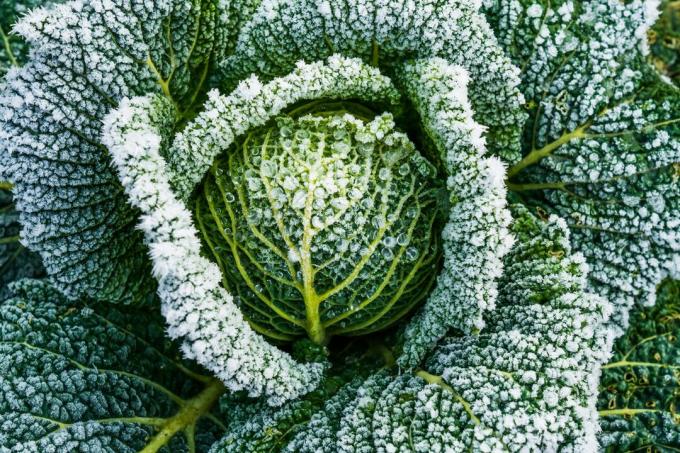
The following vegetables can still be harvested in February:
Harvest in the bed: Mushrooms, chicory, lamb's lettuce, kale, Brussels sprouts, parsnips, leeks, savoy cabbage
Harvest in greenhouse: Celeriac, spinach
More work in the vegetable garden in February
Of course, gardening in February does not only include planting and harvesting - instead, you are mainly concerned with preparatory work for the coming season. We have summarized for you here which gardening work should still be done in February.
Prepare beds: At the end of February it will be time in the garden to prepare the beds for the coming sowing. If green manure is present, it should be removed or incorporated. The soil is then loosened and compost or another organic fertilizer is incorporated. Especially if your vegetable patch is new, low in hummus and you want more fertility wish, the use of a soil activator - such as the Plantura organic soil activator - can now make sense be. This actively promotes healthy soil life and thus a loose soil structure.
Protect vegetables: Late frosts can also occur again and again in February. Anyone who is already growing the first spring vegetables in February should therefore pay particular attention to suitable frost protection: A Garden fleece protects young plants from frost and provides pleasant warmth on milder days, which stimulates the growth of the plants can accelerate.
Forcing potatoes: Who can hardly wait, delicious potatoes (Solanum tuberosum) from your own garden has the opportunity to push the plants forward as early as February. Especially at early potato varieties the seed potatoes can be pre-germinated as early as February: To do this, the tubers are spread out loosely in flat boxes and placed in as bright a place as possible at 12 to 15 °C. Further Tips for growing potatoes in your own garden can be found in our special article.
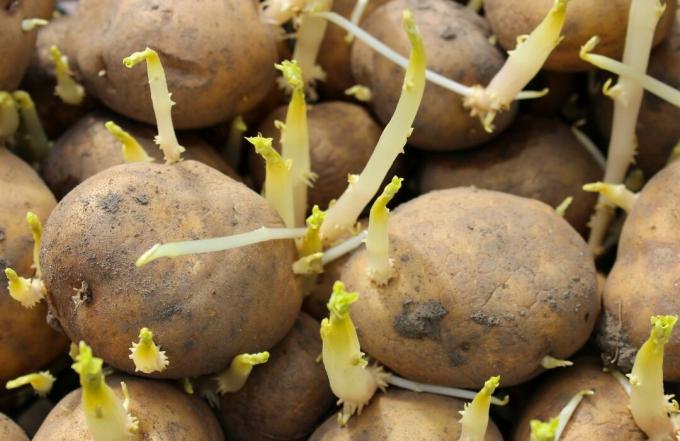
The ornamental garden in February
Even if the garden is often still pale and gray in February, the ornamental garden is often already showing its beautiful side during this time. The first flowers that bloom in February enchant us with their radiance and pleasant smell. But even in the ornamental garden, gardening should not be neglected in February - the first new plants are now being planted for a colorful summer.
What blooms in February?
Many do not know that flowers bloom in February too. In fact, there is a whole range of plants that show their flowers so early in the year and thus perform an important service in nature - the early flowering shrubs support various insects such as the brimstone butterfly or the common bumblebee, which begin their first excursions after the winter break at temperatures as low as 4 °C. But also early bloomers like crocuses (Crocus) slowly poking their heads out of the ground in February.
Which plants bloom in February?
Perennials and flowers: Wood anemone, Christmas rose, snowflake, daffodil, crocus, snowdrop, snow heather, primula, winter agaric
shrubs: Hazelnut, mahonia, winter jasmine, witch hazel

What flowers can you plant in February?
While the first flowers are already blooming in February, others still have to be sown or planted at this time of year. Especially slow-growing summer flowers how snapdragons (antirrhinum) or lobelia (Lobelia) benefit from being brought to a warm place as early as February. Anyone who missed planting spring flowering bulbs in autumn can now do so: Das Tulip Plants is also possible in February. You can also plant daffodils in February, but they often do not flower until the following year. If the ground is frost-free, it is also possible to plant bare-root roses in February.
What flowers can you plant in February?
Sowing on the windowsill or in the greenhouse: Sweet William, Begonia, Lobelia, Snapdragon, Carnation, Pelargonium, splendor candle, vanilla flower, violet
Planting outdoors: Tulip, Narcissus, Bare root roses
More work in the ornamental garden in February
In the ornamental garden, too, gardening gradually increases in February, because beds and plants have to be slowly prepared for the new gardening season. With our gardening tips for February, you can keep track of the work that still needs to be done.
Divide perennials: Perennials that bloom in late summer or autumn should be divided during gardening in February to keep them vital and floriferous. However, asters (aster), sedum (sedum) and Co. can only be shared when the ground is no longer frozen. Spring or summer flowering bulbs are only divided after flowering, otherwise they will bear fewer flowers.
Check tool: Soon the gardening will start again to the fullest. Gardeners should therefore use February to check their equipment again and, if necessary, bring it into shape.
Watering evergreens: When temperatures slowly but surely rise above freezing, it's time to start watering again. Evergreen plants such as boxwood (Buxus sempervirens) or cherry laurel (Prunus laurocerasus) evaporate a lot of water on sunny February days - so they have to be watered regularly, especially in places protected from rain.
Cutting trees and hedges: Tree pruning is one of the most important jobs to do in February. In fact, the felling or heavy pruning of hedges and trees is only permitted until April 1st. March permitted to protect any breeding birds. If you want to put your hedge on stick or want to remove a bush that has grown too large, you should use the frost-free days in February for this.
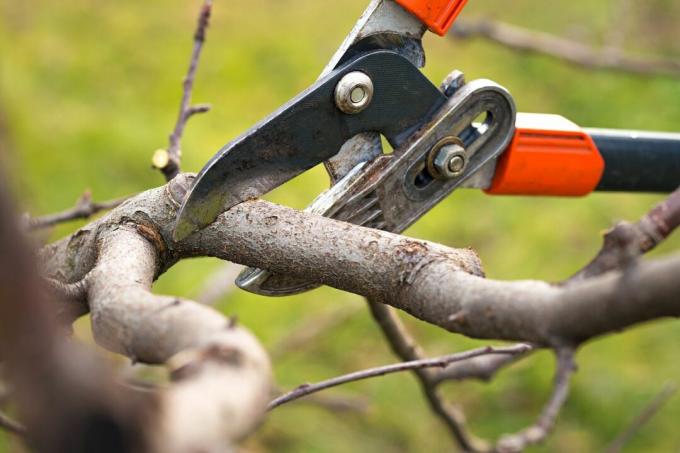
Fertilize beds and plants: Perennial beds and borders, but especially areas that are adorned with nutrient-hungry seasonal summer flowers throughout the year should now be supplied with organic fertilizer so that the given nutrients are already available at the start of the season to stand. Compost or a primarily organic complete fertilizer like ours Plantura organic flower fertilizer are ideally suited for this, as they do not lead to nutrient leaching even in winter rain in February.
The orchard in February
The orchard is often forgotten in the gardening calendar in February, because no fruit is harvested in the gray season. Nevertheless, February should also be used in the orchard. We will tell you what gardening should be done in the orchard in February.
fruit tree pruning: pome fruit like apples (penalty) and pears (Pyrus) should be pruned regularly in winter to remain vital and in shape. With frost-free, dry weather, February is perfect for pruning fruit trees.
Fertilize fruit trees: So that fruit trees have enough nutrients for lush flowering and, as a result, a rich harvest, it is worth fertilizing them once a year. Between February and April is an optimal time for the Fruit Tree Fertilization – a dose of compost or organic fertilizer is ideal at this time to compensate for the tree’s deprivation in the soil.
Control apples: Many winter apples can easily be stored well into spring if stored properly. In order to avoid unpleasant surprises, one should storage of apples nevertheless carry out regular checks. Apples that are rotten or moldy are removed from storage so that this does not spread to the other apples.
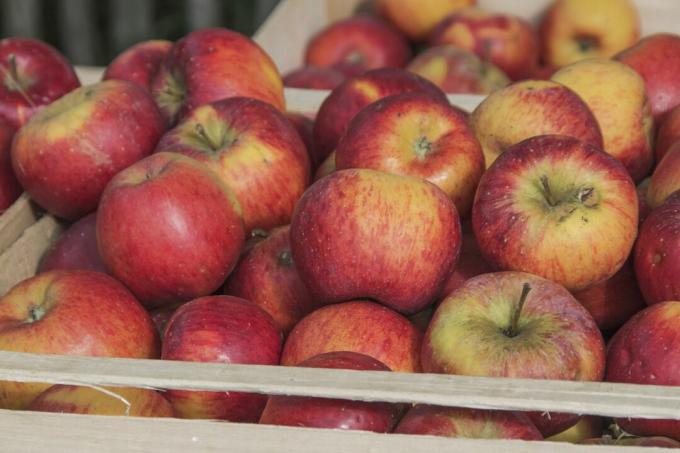
The lawn in February
Fortunately, the lawn requires very little maintenance in February because it is often still dormant for the winter. Therefore, you hardly need to worry about the lawn in the garden in February. However, it makes sense to prepare your garden tools in February for the upcoming lawn care in March. Use the free time in February and check whether the lawnmowers and scarifiers are operational or whether maintenance or repairs need to be carried out. Light, sandy soils are primarily fertilized organically between the end of February and March because they have fewer nutrients than loamy and humus-rich soils. Providing the lawn with sufficient nitrogen to drive growth now helps to strengthen its ability to compete with weeds. Ideally, a primarily organic lawn fertilizer like ours is already being used Plantura organic lawn fertilizer distributed.
Support garden animals and insects in February
Not only people suffer from the often still frosty temperatures in February - garden animals also have to struggle with numerous problems during this time. Insects such as the brimstone butterfly or the bumblebee are looking for food again for the first time, but cannot find anything in many gardens. If you want to give the busy animals a helping hand, you should focus on diversity when designing your garden.
- Plant early and late flowering perennials and shrubs in a targeted manner.
- Set up food sources for birds, for example through specially built ones bird feeder with quality birdseed like that Plantura litter.
- Clean and ice-free bird bath provide.
- Check nest boxes for damage and sweep out.
- Squirrel feeder provide.

The balcony garden in February
Not only the garden has to be maintained regularly, balcony plants also need attention in February. Here, too, everything revolves around the preparation for the coming season, flowers and planters have to be prepared and even the first flowers are sown again. We have summarized for you below which balcony plants need to be cared for in February and what other work needs to be done.
Caring for geraniums: Many balcony gardeners overwinter their geraniums (pelargonium) in a cool, dark place in the house, such as your basement. In February it's time for the balcony plant to be woken up from its hibernation - just ask move the plant to a light location (e.g. on the window sill) and start again with more intensity To water. You can also do something good for the geranium by repotting the plant in a fresh substrate. In addition, the spring cut should take place in February: horny shoots that have formed over the winter are removed completely, while new shoots are only shortened.
New plants: If you want to decorate your balcony with new roommates, you can sow and plant the first flowers on the balcony in February. Snowdrops, for example, awaken feelings of spring (Galantus nivalis), which can still move to a pot in February. But also preferred spherical primroses (Primula denticulata) can already be placed in the balcony boxes in February. In addition, the sowing can start on the balcony in February: Elfenspur (diasciahybrids) and black-eyed Susanne (Thunbergia alata) can be sown from February.
Prepare seed containers: Not all plants are suitable for sowing in February - but if you want to save time, you can already prepare flower pots and plant containers for the next generation. Containers that have already been used should be cleaned of root and soil residue. Containers that contained diseased plants should also be thoroughly boiled to completely remove any fungal spores. Those who do not want to resort to plastic or peat pots for dressing can also do so special seed boxes tinker from toilet paper rolls or eggshells.
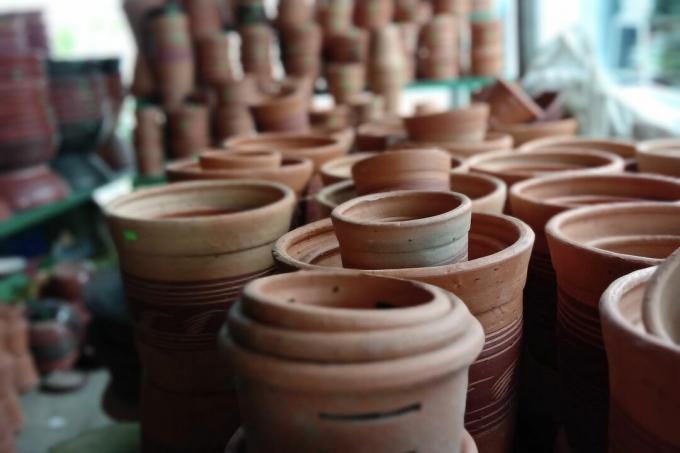
Caring for indoor plants properly in February
Indoor plants not only improve the room climate with their mere presence, but also create a pleasant, homely feeling in every room. In return, you should take extra good care of your houseplants in February When the growing season starts again, the plants need more attention than they did during theirs hibernation.
repot: Indoor plants such as cacti (Cactaceae) can be repotted at the end of February. The time is ideal, as the plants are now going back into their growth phase and the new substrate is therefore able to take root much better.
Fertilize: In line with the start of the vegetation period, it is worth supplying your houseplants with new nutrients, because the plants are on a sufficient supply during growth and the upcoming flowering reliant. A good houseplant fertilizer, like ours Plantura organic indoor & green plant fertilizer, supplies your plants with nutrients and is absolutely harmless to people and pets.
To water: If you have slowly lengthened the watering intervals in winter, you should gradually shorten them again from February to provide the plant with sufficient liquid during its growth. However, care should be taken not to give the plants too much of a good thing: waterlogging also damages houseplants in February. Therefore, only reduce the watering intervals gradually and ensure that sensitive plants have sufficient drainage in the pot.
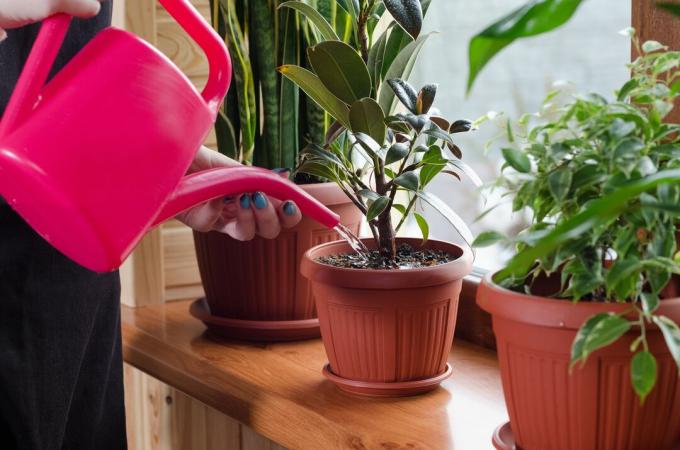
As February draws to a close, gardening really gets going. What to do then, you will learn from our article on the Gardening in March.
